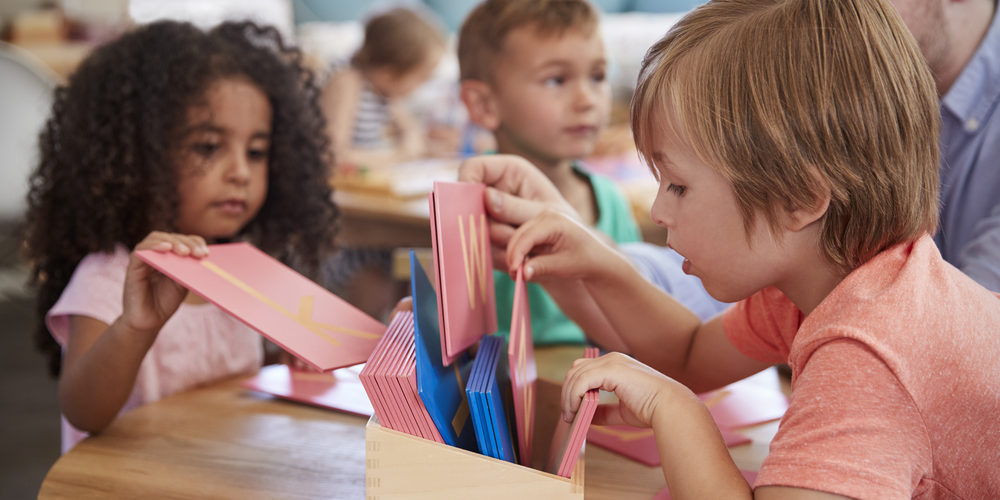Dr. Maria Montessori is often quoted for saying two intriguing things: “What the hand does, the mind remembers,” and “the hands are the instruments of man’s intelligence.” This is more than just an observation of muscle memory. Maria Montessori formed a type of early education that focuses largely on the physical and mental experiences a child has while using their senses, especially touch.
Hands-on learning, in the Montessori method, is much more beneficial than forcing a child to sit at a desk all day. Hands-on learning is the basis of all discoveries.
Think of all the times when you have watched someone do something compared to when you attempted it on your own. You’re often not perfect the first try, but with practice, you get better.
The Montessori method puts emphasis on hands-on learning for this reason. Children who work with their hands develop a more complete understanding of concepts than children who merely read or view instructions. Simply put, hands-on education is more active and engaging, and children get much more out of it than when they’re forced to sit still.
The Benefits of Hands-On Learning
Immersion into activities is a far more powerful learning tool than what is offered in the traditional classroom.
Here are some advantages of hands-on learning:
- Creates an engaging learning environment where students have to search for their own answers
- Using real-world materials and equipment enhances certain skill sets
- Hands-on learning develops critical thinking skills and resourcefulness because students have to choose their course of action
- Knowledge of the world is directly translated from sensation into knowledge
- Hands-on learning puts everything into a real-world setting, so children know what to expect
- Children can experiment multiple avenues
- Students learn about responsibility for their actions, how to collaborate with others, and how to help one another achieve their goals
Hands-On Learning in the Montessori Classroom
What does hands-on learning look like in a Philadelphia Montessori school? In programs for younger students, such as our toddler classroom at Fishtown Montessori, the children start learning with sensory items—things that they can safely touch and taste. As the children get older, they start to learn about counting with beads, wooden rods, and wooden numbers.
Later, those abstract methods are brought straight to paper, but since they develop those skills by using both the mind and body, the concepts translate more easily. For instance, when learning to read, the children might hear, touch, and see the letters before practicing drawing the shape of them.
The Montessori classroom also teaches fine motor skills, like sweeping, cutting, slicing, spraying, shoveling, and painting. As children manipulate utensils with their hands, they engage their memory and enhance the learning process. Plus, the sensations make the whole process of discovery, practice, and mastery much more entertaining.
Keeping Children Interested
The traditional classroom setting seems to invite boredom. Changing to a hands-on learning system is integral to keeping children motivated and passionate about education. Rather than sitting for hours in front of a blackboard, where children will soon relate that boredom to other tasks later in life, like reading, hands-on learning is a much more positive and fun experience.
Additionally, a hands-on education allows students to form relationships with one another. They can choose to group up or work alone in their pursuit of knowledge, and they aren’t forced to do something that doesn’t interest them. Hands-on learning allows for flexibility, where everyone remains engaged for long periods.
Hands-On Learning at Home
While your home might not be set up exactly like a Montessori classroom, hands-on learning is still possible around the house. Involvement is key. Many of the practical life skills that are taught in the classroom are needed at home, like learning how to pick up forks and spoons to set the table, peeling vegetables for snacks, and cleaning up spilled milk.
However, parents are often so busy and on auto-pilot that they forget to include the child in daily tasks. Sometimes, the child is even barred from these moments and told to go watch television, where the body is sedentary.
But what happens if you include your child in these mundane chores? Are they really that boring to the child? No, they’re not.
Including your child in chores around the house from a very young age is a low-cost way of spending time with them and teaching them lifelong skills—all while they use their hands. Next time you’re outside, invite your child to weed with you. Show them how to pick strawberries without crushing them, how to water the tomato plants, or how to care for the animals.
Allow your child into the kitchen, where they can practice cooking, cleaning, and organizing. Remember, for your child, it’s more than a chore. It’s a chance for them to exercise their body and mind, to develop self-confidence and independence.
Looking for a Montessori School in Philadelphia?
Hands-on learning is what children were designed to do. Constantly curious and seeking answers, children yearn to build skills by touching objects and working with their hands. In a Philadelphia Montessori school like Fishtown Montessori, programs are built around hands-on learning and collaborative projects. You can do the same at home, too! Give your child a chance to help out with tasks. You’ll be surprised how excited they are to contribute.
Fishtown Montessori is devoted to your child’s success. Give us a call and learn more about our programs today.






